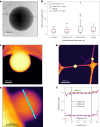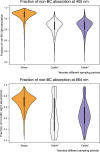Shortwave absorption by wildfire smoke dominated by dark brown carbon
- PMID: 37564378
- PMCID: PMC10409647
- DOI: 10.1038/s41561-023-01237-9
Shortwave absorption by wildfire smoke dominated by dark brown carbon
Abstract
Wildfires emit large amounts of black carbon and light-absorbing organic carbon, known as brown carbon, into the atmosphere. These particles perturb Earth's radiation budget through absorption of incoming shortwave radiation. It is generally thought that brown carbon loses its absorptivity after emission in the atmosphere due to sunlight-driven photochemical bleaching. Consequently, the atmospheric warming effect exerted by brown carbon remains highly variable and poorly represented in climate models compared with that of the relatively nonreactive black carbon. Given that wildfires are predicted to increase globally in the coming decades, it is increasingly important to quantify these radiative impacts. Here we present measurements of ensemble-scale and particle-scale shortwave absorption in smoke plumes from wildfires in the western United States. We find that a type of dark brown carbon contributes three-quarters of the short visible light absorption and half of the long visible light absorption. This strongly absorbing organic aerosol species is water insoluble, resists daytime photobleaching and increases in absorptivity with night-time atmospheric processing. Our findings suggest that parameterizations of brown carbon in climate models need to be revised to improve the estimation of smoke aerosol radiative forcing and associated warming.
Keywords: Atmospheric science; Climate sciences; Environmental impact.
© The Author(s) 2023.
Conflict of interest statement
Competing interestsThe authors declare no competing interests.
Figures










References
-
- Bond T, et al. Bounding the role of black carbon in the climate system: a scientific assessment. J. Geophys. Res. 2013;118:5380–5552. doi: 10.1002/jgrd.50171. - DOI
-
- Arias, P. A. et al. in Climate Change 2021: The Physical Science Basis (eds Masson-Delmotte, V. et al.) 33–144 (IPCC, Cambridge Univ. Press, 2021).
LinkOut - more resources
Full Text Sources
